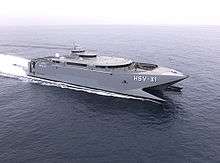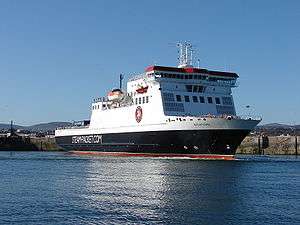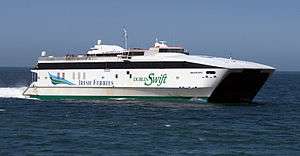HSC Manannan
 Manannan entering Douglas Harbour | |
| History | |
|---|---|
| Name: |
|
| Namesake: | Manannán mac Lir |
| Operator: |
|
| Port of registry: |
|
| Route: | |
| Builder: | Incat, Tasmania, Australia |
| Yard number: | 050 |
| Completed: | 1998 |
| Commissioned: | 1998 |
| Recommissioned: | 2009 |
| Refit: | 2001, 2009 |
| Identification: | IMO number: 9176072 |
| Status: | In service |
| General characteristics | |
| Class and type: | 96 metre WPC |
| Type: | High speed craft |
| Tonnage: | 5,743 GT[1] |
| Length: | 95.47 m (313 ft 3 in) |
| Beam: | 26.16 m (85 ft 10 in) |
| Draft: | 3.7 m (12 ft 2 in) |
| Installed power: | 4 × Caterpillar diesel engines |
| Speed: | Lightship condition 50+ knots. Fully laden 40-42 knots. |
| Capacity: |
|
HSC Manannan is a 96-metre (315 ft) wave-piercing high-speed catamaran car ferry built in Tasmania in 1998. After commercial service in Australia and New Zealand, she was chartered to the US Military as USS Joint Venture (HSV-X1). Now owned and operated by the Isle of Man Steam Packet Company, she mainly provides a seasonal service between Douglas and Liverpool.
Early history
Manannan is one of six 96-metre (WPC 96) catamarans built by Incat of Tasmania, Australia. She was built as Incat 050 in 1998. Under the name Devil Cat, she operated for a short period as a commercial ferry for TT-Line. A spell followed crossing the Cook Strait as Top Cat.[2] Then she was acquired by the US Navy and converted for military purposes.
United States Navy

In 2001, she was commissioned as USS Joint Venture (HSV-X1), serving for five years with the United States Armed Forces. A flight deck was added to accommodate various helicopters in the US Navy arsenal. Joint Venture was rapidly re-configurable and could perform a variety of missions, principal among them the ability to ferry up to 325 combat personnel and 400 tons of cargo up to 3,000 nautical miles (5,600 km) one way at speeds in excess of 40 knots (74 km/h).
In 2003, Joint Venture was assigned to Operation Enduring Freedom in the Horn of Africa.[3] She operated as a fast transport in support of the Combined Joint Task Force and performing a variety of tasks, such as transporting and supplying troops at high speed over long distances, operating as a mobile command centre, working close inshore, and operating as a helicopter carrier.
At the end of the five year charter, she was handed back to Incat in early 2006. She underwent a refit and was painted in the livery of Express Ferries. Plans for her to enter service as a car and passenger ferry never materialised.
Isle of Man Steam Packet Company
On 19 May 2008, the Isle of Man Steam Packet Company announced the purchase of the wave-piercing catamaran for £20 million, as the replacement for the fast craft Viking. Because of its previous use, the company said it had significantly fewer hours of service than a vessel of comparable age and was ideally suited for the planned service.[4] She completed the 11,868 miles (19,100 km) mile voyage from Hobart to Portsmouth, with most of the materials for her refit, in 27 days.
A £3 million refit, carried out by Burgess Marine in Portsmouth, provided a new aft accommodation module and the "Sky Lounge". The heavy military ramp was replaced with a new stern door and the helideck was removed. Following this, she arrived in Douglas on 11 May 2009. An open day took place at each of the Company's ports and at a renaming ceremony, she was renamed after Manannán mac Lir, the Celtic god of the Irish sea. Manannan made her maiden service voyage with the Steam Packet Company on Friday 22 May 2009 on the 07:30 sailing from Douglas to Liverpool.[4]
During the winter period 2014/2015 Manannan was fitted with a removable mezzanine deck which created additional space for motorcycles during the TT and Festival of Motorcycling periods, allowing fans who have previously traveled as foot passengers the chance to bring their bikes.[5] - by late March 2015, the number of motorcycles booked for the TT Festival was up 10% on the previous year.[5]
Service
At 96 metres (315 ft), Manannan is the largest vessel of its kind on the Irish Sea.[4] In summer season, she operates daily sailings from Douglas to Liverpool, and weekly/twice weekly sailings to Belfast and Dublin. During the winter, Manannan remains in Douglas on reserve and sails to Liverpool to have her annual overhaul before returning for the summer season.
Onboard facilities
The Manannan's passenger facilities are located over two decks.
Lower deck
- Blue Point café/bar
- Two Cinemas
- Coast-to-Coast café
- Junior Shipmates children's play area
- Ocean Avenue shop
- Lower outside deck
Upper deck (Sky Lounge)
- Manannan Executive Club Lounge
- Manannan Premium Lounge
- Niarbyl Reserved Lounge
- Upper outside deck
Incidents
In April 2015 the Manannan suffered six days of cancelled sailings due to damage to its jet system caused by sea debris.[6] All sailings between the Isle of Man and Liverpool were cancelled and passengers were transferred to sailings on the Ben-my-Chree to and from Heysham,[7] while the P&O vessel Express was chartered for a sailing to Larne in place of a cancelled Belfast sailing.[8] Express also suffered damage while in Manx waters and P&O were forced to cancel a number of their own sailings as a result. Steam Packet boss Mark Woodward told a local newspaper that 'Since 2007 there have been 17 recorded major incidents where our ships have been damaged and passengers have been inconvenienced by disrupted schedules as a result. Mr Woodward added: ‘It should also be noted that the damage was incurred seven days after the vessel recommenced seasonal operational service and just three weeks after leaving dry-dock. All of this equipment was fully inspected during the docking period by Steam Packet Company engineering staff, along with Classification Society Surveyors and all found to be in good order.[9] The ferry returned to service on Saturday 11 April 2015 once repairs were completed. The estimated price of repairs was above £100,000.[10]
On 24 March 2016, the Manannan collided with the Victoria Pier in Douglas Harbour on arrival at 22:30.[11] Five passengers were taken to hospital with minor injuries and the following day's sailings were cancelled, with passengers being transferred to the Ben-my-Chree. The vessel suffered damage to the port side, causing the front of the hull to be bent to the left.[12] The collision was caused by a systems control failure.[13]
Photo gallery
-

Manannan berthed in Douglas Harbour.
-
.jpg)
Manannan entering the River Mersey.
-
.jpg)
Manannan at her usual berth in Liverpool.
-
.jpg)
as USS Joint Venture (HSV-X1).
See also
References
- ↑ "HSC INCAT 050 (1998)". Fakta om Fartyg. Retrieved 2 May 2012.
- ↑ "Cook Strait Fast Ferries". History Group of the New Zealand Ministry for Culture and Heritage. Retrieved 30 June 2012.
- ↑ Sgt. Bradly Shaver, U.S. Marine Corps. "High Speed Naval Vessel Surfs African Region". Defend America. Retrieved 1 Jan 2012.
- 1 2 3 "Manannan Arrives in the Isle of Man". Maritime Reporter. 27 May 2009. Retrieved 1 July 2012.
- 1 2 "News". Isle of Man Steam Packet Company.
- ↑ "Updated story: Manannan to stay out of action for fifth and sixth day". Isle of Man Today.
- ↑ "Further disruption to Manannan sailings - Isle of Man News :: isleofman.com". isleofman.com.
- ↑ "Steam Packet borrows vessel for its Northern Irish route". Isle of Man Today.
- ↑ "Ferry the Steam Packet borrowed damaged in Manx waters". Isle of Man Today.
- ↑ Weston, Alan (10 April 2015). "Isle of Man ferry services due to resume after repairs to Manannan". Liverpool Echo.
- ↑ "PICTURES: Manannan crashes into Victoria Pier - five injured". Isle of Man Today.
- ↑ "News". Isle of Man Steam Packet Company.
- ↑ "MANANNAN – STATEMENT 10.10 HOURS – 24/03/16" (Press release). Isle of Man Steam Packet Company. March 24, 2016. Retrieved October 10, 2016.

